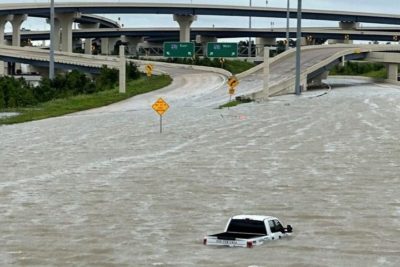Tropical Depression Beryl, which made landfall as a Category 1 hurricane on the coast of Matagorda, Texas, on Monday morning, has brought significant destruction and loss of life. Initially classified as a hurricane, Beryl was quickly downgraded first to a Tropical Storm and then to a Tropical Depression as it moved inland. Despite the downgrade, the storm’s impact has been severe, causing heavy rainfall, strong winds, and life-threatening conditions across eastern Texas.
The toll has been tragic, with eight confirmed fatalities, including seven in Texas and one in Louisiana. Among the victims was a civilian employee of the Houston Police Department who was tragically trapped in floodwaters under a highway overpass. Houston Mayor John Whitmire expressed his condolences and emphasized the ongoing risk posed by the storm. The heavy rains and strong winds have left over 2.2 million homes and businesses in the Houston area without power, exacerbating the challenges faced by residents and emergency services.
Power Outages and Recovery Efforts in Texas
As Beryl continues to surge through Texas, the state is grappling with widespread power outages and extensive damage. Acting Texas Governor Dan Patrick has announced that CenterPoint Energy is mobilizing thousands of additional workers to restore power as quickly as possible. The outages have left millions without electricity, impacting daily life and critical services in Houston, the nation’s fourth-largest city.
The utility company is working tirelessly to assess the damage and deploy crews to the hardest-hit areas. Residents are advised to stay indoors and avoid flooded areas as emergency services continue to respond to calls for assistance. The full extent of the damage is still being assessed, but the priority remains on restoring power and ensuring the safety of all affected individuals. Governor Patrick has urged residents to remain patient and vigilant as recovery efforts are underway.
Beryl’s Path of Destruction from the Caribbean to the Central US
Before making landfall in the United States, Beryl had already carved a path of destruction through Mexico and the Caribbean as a Category 5 hurricane. The storm’s intensity caused significant damage in these regions, with communities struggling to recover from the extensive flooding and wind damage. As Beryl moved northward, its strength diminished, but the impact remained severe, particularly in Texas and Louisiana.
In Louisiana, the storm caused one fatality and brought heavy rains that compounded the difficulties faced by residents. As Beryl continues its trajectory across the central US, meteorologists warn of continued risks of flash flooding and severe weather conditions. The storm’s remnants are expected to bring heavy rainfall to Michigan, posing a new threat of flash flooding in the region. Authorities are closely monitoring the situation and advising residents to take necessary precautions to protect themselves and their property.
The transition from a powerful hurricane to a tropical depression has not diminished the urgency of the situation. Emergency services and local authorities are working around the clock to respond to the immediate needs of affected communities, while also preparing for potential impacts in other states as Beryl’s remnants move northeast. The focus remains on saving lives, restoring essential services, and supporting recovery efforts in the aftermath of this devastating storm.
President Biden Offers Condolences to Houston Mayor Over Hurricane Beryl Tragedy
On Monday, the White House announced that President Joe Biden personally called Houston Mayor John Whitmire to offer his condolences following the devastating impact of Hurricane Beryl on Texas. The president expressed his sorrow over the loss of lives and assured the mayor that the federal government is committed to providing the necessary resources for both immediate relief and long-term recovery efforts.
In his conversation with Mayor Whitmire, President Biden emphasized the administration’s readiness to support the affected communities. He highlighted the deployment of the U.S. Coast Guard and the Federal Emergency Management Agency (FEMA) to assist in local response initiatives. The president, along with First Lady Jill Biden, conveyed their thoughts and prayers to those affected by the hurricane, reiterating their commitment to stand by the people of Texas throughout the recovery process.
Hurricane Beryl’s Deadly Path: A Meteorological Perspective
Hurricane Beryl has left a trail of destruction across the southeastern United States, with Texas bearing the brunt of the storm’s fury. As of now, the death toll stands at eight, with seven fatalities in Texas and one in Louisiana. The hurricane’s impact has been catastrophic, with fallen trees and dangerous floodwaters contributing to the tragic loss of life and property.
Meteorologists have warned that Beryl took the “worst possible track,” with its eye passing dangerously close to densely populated areas like Houston. Drone footage captured on July 8th revealed extensive flooding in Houston, showcasing submerged roads and overwhelmed infrastructure. Experts fear that the damage could have been even more severe if not for the rapid response of emergency services and the preparedness of local authorities.
The Human Toll: Tragic Losses Across Texas and Louisiana
The human cost of Hurricane Beryl has been heart-wrenching. In Montgomery County, Texas, three individuals lost their lives due to the storm’s ferocity. This included a man in his 40s who was struck by a falling tree while on a tractor, and a couple found deceased in a tent in a wooded area in Magnolia. Harris County reported four fatalities, including a Houston Police Department civilian employee trapped in high water and victims of fallen trees in separate incidents.
Houston Mayor John Whitmire shared the heartbreaking news of these losses at a press conference, expressing gratitude for the efforts of first responders. The tragic incidents also included a lightning-induced fire fatality and a woman in Louisiana who died when a tree fell on her home. The stories of these individuals underscore the profound impact of the storm and the urgent need for continued support and recovery efforts.
President Biden’s outreach to Mayor Whitmire, the comprehensive federal response, and the harrowing human stories emerging from the aftermath of Hurricane Beryl illustrate the storm’s devastating effects on Texas and the broader region. As the recovery process unfolds, the solidarity and resilience of the affected communities remain paramount.














